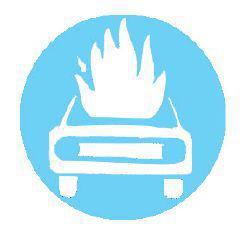SAS Urban Survival Handbook (79 page)
Read SAS Urban Survival Handbook Online
Authors: John Wiseman
Tags: #Health & Fitness, #Reference, #Survival, #Fiction, #Safety, #Self-Help, #Personal & Practical Guides, #General, #Survival Skills

► FAN BELT
SYMPTOM: IGNITION LIGHT COMES ON WHILST DRIVING
DON’T
use tights or string for a temporary belt, unless your car is an old model. Modern fan belts work under very high tension and most improvised belts won’t last a minute. Many modern engines are cooled by motor, but the ignition light might indicate a malfunctioning or broken alternator.
Carry a replacement belt. Failing this, let the engine cool (for about 30 minutes) and pick out broken bits of belt. Turn off unnecessary electrics (the battery won’t be getting topped up), then drive slowly in high gear for no more than 5 km (about 3 miles).
►
FUSES
SYMPTOM: One part of electrical system fails
There should be spare fuses in the fuse box. If not, borrow one of equal rating from a less essential circuit, for example, the rear screen heater.
NEVER
use silver foil, ordinary wire or a paper clip to bridge a fuse—it could start a fire. 13-amp household fuse wire is OK.
►
FROZEN LOCK
SYMPTOM: Obvious! You can’t insert or turn the key
Heat the key with a match and insert key until it turns.
NEVER
breathe on the lock—your mouth could stick to it and condensed moisture will make the problem worse.
►
FLOODED ENGINE
SYMPTOM: Engine won’t fire after too much choke
Push manual choke in, slowly depress accelerator fully, hold down and turn starter for a few seconds. This should blast plug ends dry.
►
CRACKED DISTRIBUTOR CAP
SYMPTOM: Engine misfires or won’t start
Lift off cap, scrape burnt plastic with nailfile/screwdriver and seal crack with nail varnish or drop of oil from dipstick.
►
JAMMED ACCELERATOR
SYMPTOM: Pedal won’t rise, revs stay high
Hook your foot under the pedal to bring it up, signal left, look for safe place to stop. Braking will be hard if revs are still high. Make temporary spring of strong rubber bands with a wire hook. Drive no faster than 50 kph (about 30 mph) to garage and DON′T jab accelerator
.
►
SHATTERED WINDSCREEN
SYMPTOM: Obvious! Toughened glass ‘crazes’, obscuring vision DON′T
punch a hole as you drive—you’ll cut yourself badly and could get glass splinters in your eyes. Lean forward to see, slow down and STOP as soon as possible. Cover heating vents, spread newspaper over bonnet and front seats, wear gloves or wrap hand, push ALL the glass out onto paper and wrap it up.
Fix tape around edge of screen or remove rubber flange and fit temporary screen if you have one. Otherwise, drive slowly to garage, wearing glasses or sunglasses to protect your eyes.
REMEMBER
When driving on a road with loose chippings, place your hand on the inside of the screen. This helps dissipate the shock if a stone hits and may prevent shattering.
SPARE PARTS KIT
- ■
Spare wheel, wheel brace and jack (check the tyre pressure regularly) - ■
Fan belt, emergency windscreen, headlamp bulbs - ■
Fuses (at least one of each type for your car) - ■
Length of HT lead (between coil, distributor and spark plugs) - ■
Can of fuel (replaced every few months, as it deteriorates) - ■
Can of water (replaced frequently), can of oil - ■
Spark plug (only one necessary—they rarely all fail at once) - ■
Strong elastic bands, rolls of insulating/plumbers’ tape - ■
Spare keys in a concealed box outside the car - ■
Screwdrivers (slot and crosshead types) - ■
Spanners (including one for spark plugs) - ■
Jump leads - ■
Baling wire (for temporary repairs to, say, exhaust pipe)
CAR SURVIVAL KIT
As well as the spare parts kit, cars should ALWAYS carry the following:
- ■
Warning triangle - ■
Fire extinguisher – BCF or dry powder - ■
First-aid kit - ■
Powerful flashlight with red filter and ‘flashing’ mode - ■
Maps
ACCIDENTS
More than 20 times as many accidents happen in built-up areas as on motorways, and most are avoidable. Often they’re caused by sheer carelessness, as is proven by the most ‘popular’ times that they occur:
- ◑ In summer and autumn
- ◑ In good weather
- ◑ On Sunday afternoons
- ◑ Late in the evening
- ◑ Closing time for public houses and nightclubs
- ◑ After work

WARNING
Fatigue creeps up slowly, especially on a monotonous ring road. Do you have full recollection of the last few miles? Are you yawning frequently? Are you imagining shadows are obstacles? You’re dangerously tired. Open a window, listen to a talk show (but only if you’re interested, otherwise it’s a soporific drone), chew a sweet, lick a finger and dampen the inner corners of your eyes. Stop for a hot drink.
REMEMBER
Obvious as it may seem, ALWAYS try to avoid any head-on collision with another vehicle or a fixed object such as a wall or tree—these are the most dangerous accidents of all. Aim to scrape along a wall. Go for dense bushes, not a solid tree. If a car is heading straight for you, brake (not violently, or you’ll skid) and scan the road for an escape. Remember the other driver might try to pull over in the same place as you, so only turn when you see which way he’s swerving. Turn away from him, even if you have to sidescrape an ‘innocent’ car.
TOP TEN ACCIDENT CAUSES
Statistics tell us everything we need to know about our driving ‘mistakes’. Unfortunately, the resultant death toll is enormous—and increasing. If you are honest with yourself, you KNOW if you are taking unnecessary risks when driving. Look through this list and see if you can make using the roads safer. Starting with the most common cause of accidents:
- ■
Careless, dangerous or drunk-driving on a straight road or ignoring/ misjudging traffic signals - ■
Misjudging a right turn or crashing into someone turning - ■
Overtaking dangerously - ■
Bad parking or getting out of a parked car - ■
Impatient driving – for example, overtaking on the inside or U-turns - ■
Turning left and swinging out too wide - ■
Stopping suddenly or unexpectedly - ■
Pulling out carelessly or bumping the car in front in a slow queue - ■
Reversing into something or someone
After an accident
If you are involved in any accident—major OR minor—the law requires you to take specific steps. Your insurance firm will need to know certain details. You may be injured or in shock—you will definitely be shaken up—but it’s in everyone’s interests to KEEP A COOL HEAD.

WARNING
If there is serious injury, the first priority MUST be to apply first aid and call an ambulance. If fuel is leaking, and there is ANY danger of fire or explosion, DON′T smoke. Move everyone back to a safe distance.
1
STOP! Even if your own vehicle is OK (for example, if someone else swerved to avoid you and crashed).
2
If you’ve caused an obstruction, ensure there are no further accidents by getting someone to stop or direct oncoming traffic.
3
DON′T argue about what happened, and don’t admit liability.
4
If anyone saw the accident, take their name and address so they can make a statement to your insurance company.
5
Call the police (and an ambulance) if there is serious injury, traffic obstruction or damage to vehicles or property. Inform them later if you damaged an unoccupied car—it’s an offence not to.

EMERGENCY!
CAR FIRE
Car fires are usually started by faulty wiring and/or leaking petrol. A fire may start as a result of a collision or a dropped cigarette on a garage forecourt or similar.
►
You must act quickly, to put out the fire
Petrol is extremely volatile—if the vapour ignites, it’s likely that the tank may explode
►
Switch off the ignition
In most cases, this will stop the fuel pump
FIRE ON THE MOVE
Coast to the side of the road, STOP and get everyone out of the car
FIRE UNDER BONNET
DON′T raise bonnet—you’ll fan the flames higher. Open it just enough to insert fire extinguisher nozzle. Direct at base of flames, from edge to middle, side to side—leave no patch unsmothered
IF YOU HAVE NO EXTINGUISHER
Smother flames with any thick material to hand—car rug (wool, NOT man-made fibre), wool coat. Call fire brigade. Get all passengers back to a safe distance
FIRE NOT UNDER BONNET
Disconnect battery. Use fire extinguisher, if site of fire is accessible. Back off and call fire brigade
REMEMBER
You MUST carry a fire extinguisher in your car. Keep it mounted on the dashboard or by your feet – NOT in the boot!
6
Make a sketch of the scene before anything is moved: road names, position of trees and lampposts, road markings, position of vehicles in relation to each other, length and position of skid marks.
7
Make a note of damage sustained by ALL vehicles involved. If you’ve got a camera with you, even better—you need as accurate a record of the damage as possible.
8
Collect names, addresses and registration numbers and give your own. If anyone refuses, note their car registration number—it can be traced.
9
If someone is injured, you MUST produce your insurance certificate there and then, or report to the police within 24 hours.
